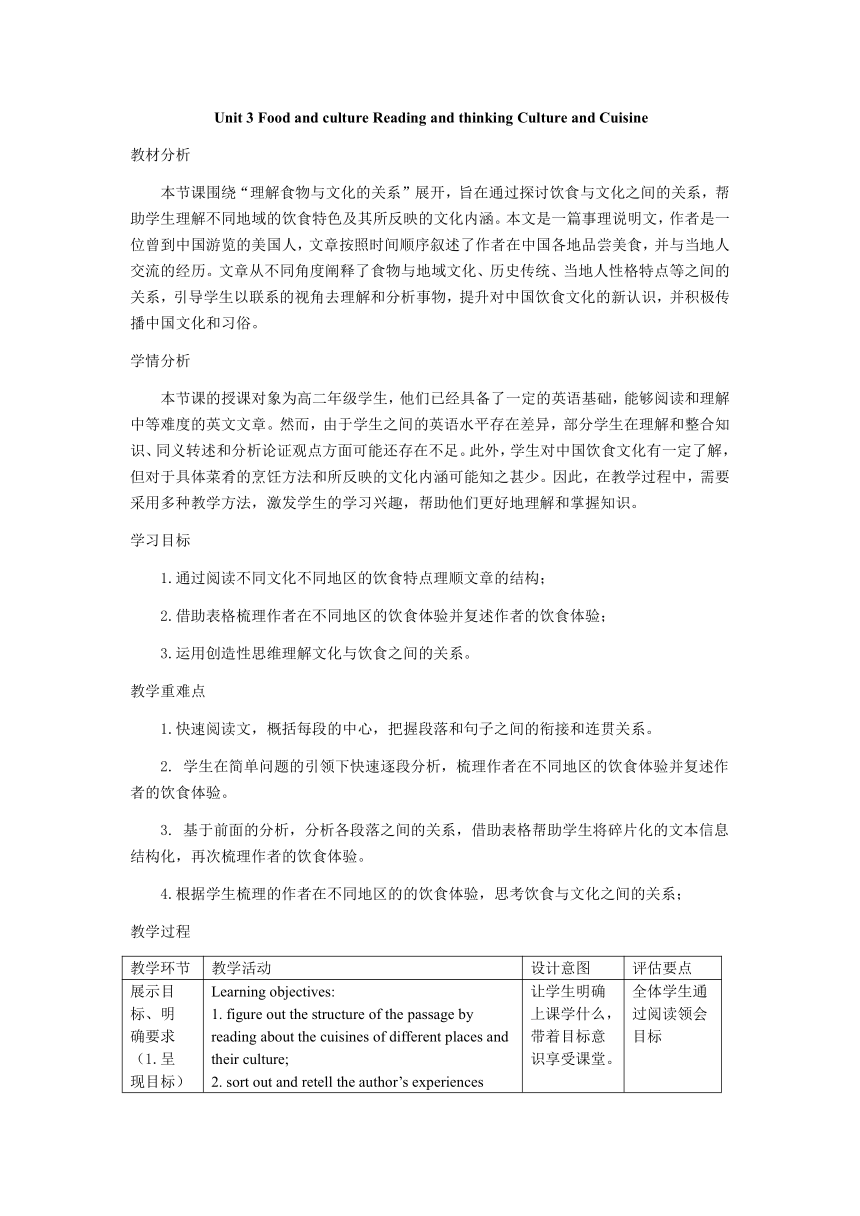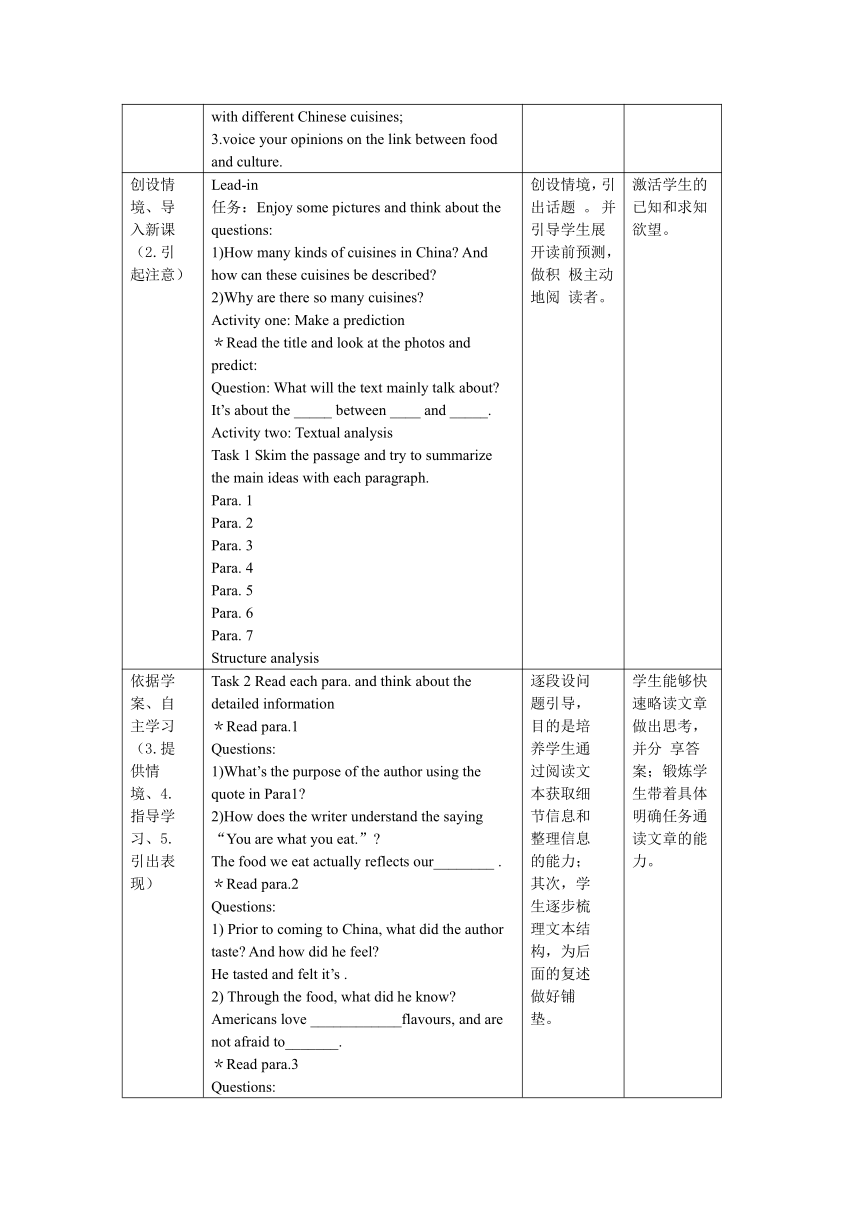人教版(2019)选择性必修第二册Unit 3 Food and culture Reading and thinking 教学设计(表格式)
文档属性
| 名称 | 人教版(2019)选择性必修第二册Unit 3 Food and culture Reading and thinking 教学设计(表格式) |  | |
| 格式 | docx | ||
| 文件大小 | 55.8KB | ||
| 资源类型 | 教案 | ||
| 版本资源 | 人教版(2019) | ||
| 科目 | 英语 | ||
| 更新时间 | 2025-01-15 10:22:12 | ||
图片预览


文档简介
Unit 3 Food and culture Reading and thinking Culture and Cuisine
教材分析
本节课围绕“理解食物与文化的关系”展开,旨在通过探讨饮食与文化之间的关系,帮助学生理解不同地域的饮食特色及其所反映的文化内涵。本文是一篇事理说明文,作者是一位曾到中国游览的美国人,文章按照时间顺序叙述了作者在中国各地品尝美食,并与当地人交流的经历。文章从不同角度阐释了食物与地域文化、历史传统、当地人性格特点等之间的关系,引导学生以联系的视角去理解和分析事物,提升对中国饮食文化的新认识,并积极传播中国文化和习俗。
学情分析
本节课的授课对象为高二年级学生,他们已经具备了一定的英语基础,能够阅读和理解中等难度的英文文章。然而,由于学生之间的英语水平存在差异,部分学生在理解和整合知识、同义转述和分析论证观点方面可能还存在不足。此外,学生对中国饮食文化有一定了解,但对于具体菜肴的烹饪方法和所反映的文化内涵可能知之甚少。因此,在教学过程中,需要采用多种教学方法,激发学生的学习兴趣,帮助他们更好地理解和掌握知识。
学习目标
1.通过阅读不同文化不同地区的饮食特点理顺文章的结构;
2.借助表格梳理作者在不同地区的饮食体验并复述作者的饮食体验;
3.运用创造性思维理解文化与饮食之间的关系。
教学重难点
1.快速阅读文,概括每段的中心,把握段落和句子之间的衔接和连贯关系。
2. 学生在简单问题的引领下快速逐段分析,梳理作者在不同地区的饮食体验并复述作者的饮食体验。
3. 基于前面的分析,分析各段落之间的关系,借助表格帮助学生将碎片化的文本信息结构化,再次梳理作者的饮食体验。
4.根据学生梳理的作者在不同地区的的饮食体验,思考饮食与文化之间的关系;
教学过程
教学环节 教学活动 设计意图 评估要点
展示目 标、明 确要求 (1.呈 现目标) Learning objectives: 1. figure out the structure of the passage by reading about the cuisines of different places and their culture; 2. sort out and retell the author’s experiences with different Chinese cuisines; 3.voice your opinions on the link between food and culture. 让学生明确上课学什么,带着目标意识享受课堂。 全体学生通 过阅读领会目标
创设情 境、导 入新课 (2.引 起注意) Lead-in 任务:Enjoy some pictures and think about the questions: 1)How many kinds of cuisines in China And how can these cuisines be described 2)Why are there so many cuisines Activity one: Make a prediction *Read the title and look at the photos and predict: Question: What will the text mainly talk about It’s about the _____ between ____ and _____. Activity two: Textual analysis Task 1 Skim the passage and try to summarize the main ideas with each paragraph. Para. 1 Para. 2 Para. 3 Para. 4 Para. 5 Para. 6 Para. 7 Structure analysis 创设情境,引出话题 。 并引导学生展开读前预测,做积 极主动地阅 读者。 激活学生的已知和求知 欲望。
依据学 案、自 主学习 (3.提 供情 境、4. 指导学 习、5. 引出表 现) Task 2 Read each para. and think about the detailed information *Read para.1 Questions: 1)What’s the purpose of the author using the quote in Para1 2)How does the writer understand the saying “You are what you eat.” The food we eat actually reflects our________ . *Read para.2 Questions: 1) Prior to coming to China, what did the author taste And how did he feel He tasted and felt it’s . 2) Through the food, what did he know Americans love ____________flavours, and are not afraid to_______. *Read para.3 Questions: 1) Later, he came to Beijing, what did the author taste And how did he feel He tasted and felt it’s ________________. 2) Through the food, what did he know People offer_________ through food. *Read para.4 Questions: 1) Soon, he came to Shandong, what did the author taste And how did he feel He tasted and felt It’s _____________________. 2) Through the food, what did he know _________is important to people there. *Read para.5 Questions: 1) Then, he came to Xinjiang, what did the author taste He tasted__________________ . 2) Through the food, what did he know He learnt their lifestyles there was________ . *Read para.6 Questions: 逐段设问 题引导, 目的是培 养学生通 过阅读文 本获取细 节信息和 整理信息 的能力; 其次,学 生逐步梳 理文本结 构,为后 面的复述 做好铺 垫。 学生能够快 速略读文章做出思考,并分 享答案;锻炼学 生带着具体明确任务通读文章的能力。
教师引 领,提 升能力 (6.反 馈评 价) 1) Then, he came to Guangdong and Henan, what did the author taste And how did he feel He tasted in Guangdong and in Henan and felt Guangdong cuisine was and Henan cuisine Was________ . 2) Through the food, what did he know Chinese people everywhere show ______. *Read para.7 Questions: 1) What can the food local people consume tell us It can tell us__________. 2) Find out the topic sentence of this para. Task 3 Read again and think about in what order the rest of the passage is organized The passage is organized by order and order. 对应目标 1:Figure out the main structure and sort out the author’s experiences with different Chinese cuisines; Activity three: Summary 引导学生 以表格形 式将碎片 化的信息 结构化, 更加直观 地展现作 者的不同 地区的饮 食体验。 让学生重 组语篇信 息,用话 题词汇和 功能语言 复述文章 内容。 学生自主填 空, 然后 有两名 学生展示 复述。通过 这个活动,激发学生 学习兴趣, 锻炼学生自主学习能力。 学生先自 主探究 , 再小组分 享,查漏 补缺。
小组讨 论(7. 课文迁 移与运 用) 小组合 作、探 究,(8. 发展创 造性思 维) Activity four: Critical thinking * Group discussion Do you think“culture and cuisine go hand in hand” Give your reasons. Agree: _______________________ Disagree:_____________________________ 对应目标 3: voice your opinions on the link between food and culture 通过关注学 生的表述 (关注内 容和语 言),由 此判断学 生的思维 能力是否 得到锻炼和提升
课堂小 结 Activity five: Reflection 1. figure out the structure of the passage by reading about the cuisines of different places and their culture; 2. sort out and retell the author’s experiences with different Chinese cuisines; 3.voice your opinions on the link between food and culture. Activity six: Assignment 1) Review what you have learned in the class 2) Finish the passage according to what you have discussed. 用 PPT重 新展示回扣学习目标, 学生说收 获,老师 板书总结 , 逐 一核查。 学生课下自主回 扣学习内容。
教材分析
本节课围绕“理解食物与文化的关系”展开,旨在通过探讨饮食与文化之间的关系,帮助学生理解不同地域的饮食特色及其所反映的文化内涵。本文是一篇事理说明文,作者是一位曾到中国游览的美国人,文章按照时间顺序叙述了作者在中国各地品尝美食,并与当地人交流的经历。文章从不同角度阐释了食物与地域文化、历史传统、当地人性格特点等之间的关系,引导学生以联系的视角去理解和分析事物,提升对中国饮食文化的新认识,并积极传播中国文化和习俗。
学情分析
本节课的授课对象为高二年级学生,他们已经具备了一定的英语基础,能够阅读和理解中等难度的英文文章。然而,由于学生之间的英语水平存在差异,部分学生在理解和整合知识、同义转述和分析论证观点方面可能还存在不足。此外,学生对中国饮食文化有一定了解,但对于具体菜肴的烹饪方法和所反映的文化内涵可能知之甚少。因此,在教学过程中,需要采用多种教学方法,激发学生的学习兴趣,帮助他们更好地理解和掌握知识。
学习目标
1.通过阅读不同文化不同地区的饮食特点理顺文章的结构;
2.借助表格梳理作者在不同地区的饮食体验并复述作者的饮食体验;
3.运用创造性思维理解文化与饮食之间的关系。
教学重难点
1.快速阅读文,概括每段的中心,把握段落和句子之间的衔接和连贯关系。
2. 学生在简单问题的引领下快速逐段分析,梳理作者在不同地区的饮食体验并复述作者的饮食体验。
3. 基于前面的分析,分析各段落之间的关系,借助表格帮助学生将碎片化的文本信息结构化,再次梳理作者的饮食体验。
4.根据学生梳理的作者在不同地区的的饮食体验,思考饮食与文化之间的关系;
教学过程
教学环节 教学活动 设计意图 评估要点
展示目 标、明 确要求 (1.呈 现目标) Learning objectives: 1. figure out the structure of the passage by reading about the cuisines of different places and their culture; 2. sort out and retell the author’s experiences with different Chinese cuisines; 3.voice your opinions on the link between food and culture. 让学生明确上课学什么,带着目标意识享受课堂。 全体学生通 过阅读领会目标
创设情 境、导 入新课 (2.引 起注意) Lead-in 任务:Enjoy some pictures and think about the questions: 1)How many kinds of cuisines in China And how can these cuisines be described 2)Why are there so many cuisines Activity one: Make a prediction *Read the title and look at the photos and predict: Question: What will the text mainly talk about It’s about the _____ between ____ and _____. Activity two: Textual analysis Task 1 Skim the passage and try to summarize the main ideas with each paragraph. Para. 1 Para. 2 Para. 3 Para. 4 Para. 5 Para. 6 Para. 7 Structure analysis 创设情境,引出话题 。 并引导学生展开读前预测,做积 极主动地阅 读者。 激活学生的已知和求知 欲望。
依据学 案、自 主学习 (3.提 供情 境、4. 指导学 习、5. 引出表 现) Task 2 Read each para. and think about the detailed information *Read para.1 Questions: 1)What’s the purpose of the author using the quote in Para1 2)How does the writer understand the saying “You are what you eat.” The food we eat actually reflects our________ . *Read para.2 Questions: 1) Prior to coming to China, what did the author taste And how did he feel He tasted and felt it’s . 2) Through the food, what did he know Americans love ____________flavours, and are not afraid to_______. *Read para.3 Questions: 1) Later, he came to Beijing, what did the author taste And how did he feel He tasted and felt it’s ________________. 2) Through the food, what did he know People offer_________ through food. *Read para.4 Questions: 1) Soon, he came to Shandong, what did the author taste And how did he feel He tasted and felt It’s _____________________. 2) Through the food, what did he know _________is important to people there. *Read para.5 Questions: 1) Then, he came to Xinjiang, what did the author taste He tasted__________________ . 2) Through the food, what did he know He learnt their lifestyles there was________ . *Read para.6 Questions: 逐段设问 题引导, 目的是培 养学生通 过阅读文 本获取细 节信息和 整理信息 的能力; 其次,学 生逐步梳 理文本结 构,为后 面的复述 做好铺 垫。 学生能够快 速略读文章做出思考,并分 享答案;锻炼学 生带着具体明确任务通读文章的能力。
教师引 领,提 升能力 (6.反 馈评 价) 1) Then, he came to Guangdong and Henan, what did the author taste And how did he feel He tasted in Guangdong and in Henan and felt Guangdong cuisine was and Henan cuisine Was________ . 2) Through the food, what did he know Chinese people everywhere show ______. *Read para.7 Questions: 1) What can the food local people consume tell us It can tell us__________. 2) Find out the topic sentence of this para. Task 3 Read again and think about in what order the rest of the passage is organized The passage is organized by order and order. 对应目标 1:Figure out the main structure and sort out the author’s experiences with different Chinese cuisines; Activity three: Summary 引导学生 以表格形 式将碎片 化的信息 结构化, 更加直观 地展现作 者的不同 地区的饮 食体验。 让学生重 组语篇信 息,用话 题词汇和 功能语言 复述文章 内容。 学生自主填 空, 然后 有两名 学生展示 复述。通过 这个活动,激发学生 学习兴趣, 锻炼学生自主学习能力。 学生先自 主探究 , 再小组分 享,查漏 补缺。
小组讨 论(7. 课文迁 移与运 用) 小组合 作、探 究,(8. 发展创 造性思 维) Activity four: Critical thinking * Group discussion Do you think“culture and cuisine go hand in hand” Give your reasons. Agree: _______________________ Disagree:_____________________________ 对应目标 3: voice your opinions on the link between food and culture 通过关注学 生的表述 (关注内 容和语 言),由 此判断学 生的思维 能力是否 得到锻炼和提升
课堂小 结 Activity five: Reflection 1. figure out the structure of the passage by reading about the cuisines of different places and their culture; 2. sort out and retell the author’s experiences with different Chinese cuisines; 3.voice your opinions on the link between food and culture. Activity six: Assignment 1) Review what you have learned in the class 2) Finish the passage according to what you have discussed. 用 PPT重 新展示回扣学习目标, 学生说收 获,老师 板书总结 , 逐 一核查。 学生课下自主回 扣学习内容。
